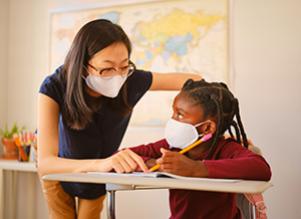8/16/2020
For Student Teachers, An Uncertain Fall Semester Ahead
Over the past few months, the COVID-19 pandemic has swiftly impacted almost all aspects of life as we know it, turning daily routines upside down and adding new intricacies to previously familiar tasks. In the education sector, schools across the country have been affected by closures—some of which have no clear end in sight.
Much of the coverage during this time has examined how the abrupt transition to remote learning has impacted students, parents taking on the role of “teacher” for their children, and educators trying their best to keep momentum and student progress on track. Among these players, student teachers face a unique and uncertain predicament: Not only are their experiences in the classroom on hold, they are physically disconnected from their universities as well.
So, what does the new normal look like for student teachers poised to begin teaching on their own in the fall?
Revised licensure requirements
With teacher shortages and the unequal distribution of qualified educators across high- and low-poverty schools on the rise even before the pandemic, a year without new teachers joining the workforce would be a massive blow to an education system already struggling with onboarding and retention. At the same time, it is imperative that any and all new teachers adhere to a certain professional standard in order to be licensed, which creates a delicate but critical balancing act.
Needless to say, many states are revising their teacher licensure approaches to accommodate the challenges posed by the pandemic. While the specifics vary from state to state, a recent analysis by the National Council on Teacher Quality indicated that these changes are largely taking one of two forms:
-
States such as California, New Jersey, and New York have opted to allow “non-traditional instruction”—including online learning—to be counted toward clinical experience, with observation taking place remotely or via video recordings.
-
States such as Missouri, Texas, and Vermont have waived or reduced the overall length requirement for student teaching, instead allowing candidates to be assessed based on work already completed—even when the minimum number of hours in the classroom has not been met.
Governments are also taking factors like standardized tests into consideration, with some allowing student teachers to begin on their own in the fall and waiving certification tests until the end of the academic year while others are issuing provisional certificates that allow for business as usual in the fall but require tests to be completed within a given amount of time.
As Tanji Reed Marshall of The Education Trust pointed out, expenses such as application fees can be a barrier for some student teachers, especially teachers of color. And with research indicating that a diverse teaching workforce positively impacts outcomes for students of color, it is particularly important to support the advancement of nonwhite educators by keeping the financial aspect in check. According to Marshall, this “might mean delaying the cost until people start teaching, waiving fees, or making [fees] proportional to a candidate’s current income.”
The human element
In addition to the myriad procedural revisions necessitated by the pandemic, a much simpler factor is also affecting student teachers: They miss their kids.
“Being a student teacher, you’re in a weird spot where you try and build relationships as quickly as you can because you want to connect with the students and kind of dive in, and I think you don’t realize how much these kids will matter,” seventh-grade student teacher Ashley Cosgrove told The 74. “They’re really special to you because they’re really your first students, and there’s just no closure to that.”
Of course, many student teachers continue to be involved in remote versions of lesson planning, student communication, and other core educator responsibilities, yet they may feel they are not getting as much out of the experience as they should be. That said, The 74 pointed out that districts forced to adapt their processes due to the pandemic can use this opportunity to strengthen their student-teacher programs.
As Cosgrove phrased it, “I can’t help but think that there’s going to be so much insight from this that we would have never had the opportunity to get had we not been in this situation.”


